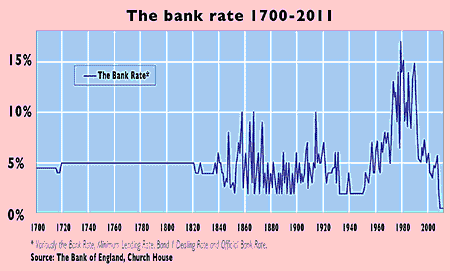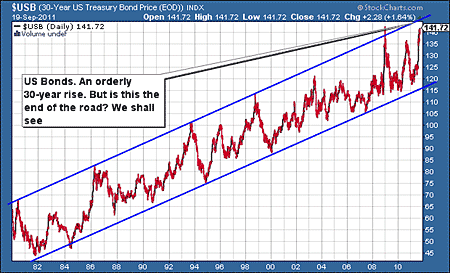The word ‘bubble’ gets bandied about a lot.
Many people get hot under the collar arguing over whether something is in a bubble or not. But, just as in heated inflation-deflation debates, few take the trouble to agree on a definition first.
I’ve always rather liked my definition. ‘A bubble is a bull market in which you don’t have a position’. There’s nothing so frustrating as seeing someone of undoubtedly inferior intelligence earn fortunes while you’re sat on the sidelines. So you declare his market a bubble.
But I doubt my definition will ever make it into the conventional lexicon, so we’ll have to agree on an alternative in today’s Money Morning, as we consider whether the government bond market is in a bubble or not…
A confession – I hate governments
Let me first declare a vested interest.
I hate governments. I loathe and despise them, all of them, even the good ones. I don’t know if I’m a libertarian, an anarchist or just a plain old crank, but I trace the blame for so much ill in the world – from war to poverty to the destruction of the environment – all the way to governments.
So, let’s just say, I’m a little bit biased.
The UK and US government bond markets are both, very much, ‘bull markets in which I don’t have a position’. (And I’m glad I don’t. Those that know me well might well declare that I am a man of few principles, but I have enough to draw the line at lending a government money. Think what they might do with it.)
But are developed government bond markets in a bubble? Let’s use King, Smith, Williams and Van Boening’s 1993 definition: a bubble is “trade in high volumes at prices that are considerably at variance with intrinsic values“.
At present the US government can borrow money over ten years and pay under 2% a year. Germany need only pay 1.8%. The UK can borrow at 2.3% – considerably lower than inflation, which sits between 4% and 5%, depending on what measure you use. (And bear in mind that real inflation as suffered by the man who wants to eat, drink, travel and keep warm is considerably higher.)
If somebody approached you and said: “Psst. Have I got an investment opportunity for you! Lend me money and I’ll guarantee you’ll lose 2% to 3%, year in, year out.” Unless that somebody was extremely charming – or armed – it’s unlikely you’d see this as an ‘opportunity’.
Government bond markets are a huge bubble
Yet, as Allister Heath writes in The Spectator this week, “UK and American governments can be loaned money – and, in effect, be paid for the privilege. This is crazy. It shows that the bond markets are well and truly in major bubble territory, their valuations as absurd as the rocketing subprime properties of yore.”
Our own Merryn Somerset Webb is fond of posting her long-term chart of UK interest rates (see below), declaring it: “The most important chart you will ever see.” For all the charts I’ve posted over the years, I kind of agree with her. You can see just how absurdly low the bank rate is right now – indeed, it hasn’t been lower in over 300 years.

Sure, these are short-term interest rates rather than long-term ones. But if you ever needed a single image that sums up just how distorted our financial system has become, this chart is it.
We know that both the US and the UK are broke. We know that they are systematically trying to devalue their currencies. We know that they have no hope of paying back their debt obligations. And we know that in an environment of higher rates they wouldn’t even be able to service the interest on their debt. So why lend them money?
I don’t know when this will unravel. But I know it will. This is an artificial situation and Mother Nature will not let it last.
Where will money flee to when the bond bubble pops?
So here are two things to think about. First, there’s the speed at which it could unravel. In late 2009 ten-year Greek debt was at 4.5%. Now it’s nearer 25%. 25% interest rates! Imagine that here.
Second, there’s the sums involved. The easy money of the Alan Greenspan and Ben Bernanke era has been ‘invested’ in government bonds. Large portions of the titanic wealth that has built up in the Far East and in the resource-rich nations over the last ten years has made its way into the government bond market. The stock market tanks and more money flees to the comparative safety of the bond market. Where is all that money going to run to when the bond bubble pops? Something shiny and yellow maybe?
For now, bonds are finding a bid. I’ve called the top before back at the end of 2008 and been wrong. So I’m not saying it’ll be over tomorrow or even next week. But I am saying it can’t go on forever and it’s reached the levels of silliness you find at the latter stages of a bull market.
Here we see a long-term chart of US government bonds. You can see the steady rise higher and higher.

We could be making a double top here and now. I don’t know. But I shall be watching that lower, rising trend line. If that breaks, it’s guns, cans and hills time.
As Heath writes: “If debt starts to be priced at normal rates, the adjustment will be agonising – not least for Osborne’s government. How many Brits would be comfortable if their mortgage interest rates went back to 6%, which was normal, even cheap, for so much of our recent history? Or 10%? Trillions of pounds’ worth of pension and insurance money is invested in bonds, so when they crash it will destroy wealth on a massive scale. Stock markets will fall, in some cases severely, while the great property boom will give way to a crash – as the cost of mortgages climbs permanently higher.”
In short, if you thought 2008 was bad, if you think now is bad, just wait for this one to pop. It’ll be monetary mayhem and you’ll be mighty glad you’ve got your gold.
I should add, spiralling rates will eventually be bad news for gold. They did for it in 1980. It’s part of my end game scenario. But in 1980 it took rates at over 15% to kill gold’s bull market. We know the world can’t even take rates at 6%. In the monetary mayhem that would ensue during the spiking rates of a collapsing bond market, that’s when gold will go really ballistic. And it won’t stop till they get the bond market back under control – and gold is legal tender once again.
Category: Market updates

